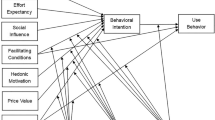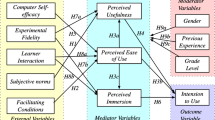Abstract
The use of virtual reality (VR) has become a viable alternative to conventional learning methods in various knowledge domains. Wearable head-mounted displays (HMDs) are devices that provide users with an immersive VR experience. To investigate the direct determinants affecting students’ reasons for HMD use in learning, hypotheses relating to information technology acceptance and Kolb’s learning styles were proposed and tested in this study. Participants were recruited through stratified random sampling according to the population ratio of colleges at a university in Taiwan. Students were shown a video on VR applications in learning, after which an online survey was completed. In total, 387 questionnaires were collected of which 376 were valid. An inference analysis of the samples was performed by structural equation modelling with eight exogenous latent variables, namely the four constructs of the unified theory of acceptance and use of technology (UTAUT) and the four modes of Kolb’s learning styles. All eight variables pointed to one endogenous latent variable: behavioural intention. The results showed all four constructs of the UTAUT to have a positive and significant effect on students’ behavioural intention to use HMDs in learning and only the concrete experience mode of Kolb’s learning styles to have a positive and significant effect. Based on these findings, this study provides suggestions on how to encourage HMDs use in learning to VR developers and educational institutions.
Access this article
We’re sorry, something doesn't seem to be working properly.
Please try refreshing the page. If that doesn't work, please contact support so we can address the problem.


Similar content being viewed by others
References
AbuShanab E, Pearson JM, Setterstrom AJ (2010) Internet banking and customers’ acceptance in Jordan: the unified model’s perspective. Commun Assoc Inf Syst 26:493–524
Ajzen I, Fishbein M (1975) Understanding attitudes and predicting social behaviour. Prentice Hall, Englewood Cliffs
Aldás-Manzano J, Ruiz-Mafe C, Sanz-Blas S (2009) Exploring individual personality factors as drivers of M-shopping acceptance. Ind Manag Data Syst 109:739–757
Ali NS, Nasser M (2017) Review of virtual reality trends (previous, current, and future directions), and their applications, technologies and technical issues. J Eng Appl Sci 12:783–789
Al-Qeisi K, Dennis C, Alamanos E, Jayawardhena C (2014) Website design quality and usage behavior: unified theory of acceptance and use of technology. J Bus Res 67:2282–2290
Anderson JC, Gerbing DW (1988) Structural equation modeling in practice: a review and recommended two-step approach. Psychol Bull 103:411–423
Antonieta A (2014) Immersive simulation of architectural spatial experiences. Blucher Des Proc 1:495–499
Bandura A (1986) Social foundations of thought and action. Prentice Hall, Englewood Cliffs
Barnett T, Pearson AW, Pearson R, Kellermanns FW (2015) Five-factor model personality traits as predictors of perceived and actual usage of technology. Eur J Inf Syst 24:374–390
Bollen KA, Stine RA (1992) Bootstrapping goodness-of-fit measures in structural equation models. Sociol Methods Res 21:205–229
Carlsson C, Carlsson J, Hyvonen K, Puhakainen J, Walden P (2006) Adoption of mobile devices/services—searching for answers with the UTAUT. In: Proceedings of the 39th annual hawaii international conference on system sciences (HICSS’06), pp 132a–132a
Cheong JH, Park M-C, Hwang J (2004) Mobile payment adoption in Korea: switching from credit card. Paper presented at the ITS 15th Biennial conference, Berlin, Germany
Chiu CM, Wang ETG (2008) Understanding web-based learning continuance intention: the role of subjective task value. Inf Manag 45:194–201
Compeau DR, Higgins CA (1995) Computer self-efficacy: development of a measure and initial test. MIS Q 19:189–211
Davis FD (1989) Perceived usefulness, perceived ease of use, and user acceptance of information technology. MIS Q 13:319–340
Devaraj S, Easley RF, Crant JM (2008) Research note-how does personality matter? Relating the five-factor model to technology acceptance and use. Inf Syst Res 19:93–105
Fishbein M, Ajzen I (1975) Belief, attitude, intention and behavior: an introduction to theory and research. Addison-Wesley, Philippines
Goodhue DL (1995) Understanding user evaluations of information systems. Manag Sci 12:1827–1844
Goodhue DL, Thompson RL (1995) Task-technology fit and individual performance. MIS Q 19:213–236
Hair JF, Black WC, Babin BJ, Anderson RE, Tatham RL (2006) Multivariate data analysis, 6th edn. Pearson Prentice Hall, Uppersaddle River
Haller M, Kurka G, Volkert J, Wagner R (1999) omVR–A safety training system for a virtual refinery. Paper presented at the topical workshop on virtual reality and advanced human–robot systems, Tokyo, Japan
Hanson K, Shelton BE (2008) Design and development of virtual reality: analysis of challenges faced by educators. J Educ Technol Soc 11:118–131
Hauptman H, Cohen A (2011) The synergetic effect of learning styles on the interaction between virtual environments and the enhancement of spatial thinking. Comput Educ 57:2106–2117
Hu PJ, Chau PYK, Sheng ORL, Tam KY (1999) Examining the technology acceptance model using physician acceptance of telemedicine technology. J Manag Inf Syst 16:91–112
IDC (2017) Worldwide shipments of AR and VR headsets expected to grow at 58% CAGR with low-cost smartphone VR devices being short-term catalyst, According to IDC. http://www.idc.com/getdoc.jsp?containerId=prUS42807717. Accessed 9 Feb 2018
Jonassen DH (2000) Transforming learning with technology: beyond modernism and post-modernism or whoever controls the technology creates the reality. Educ Technol 40:21–25
Jordanov WL (2001) An examination of the relationship between learning style and technology use. Paper presented at the annual meeting of the mid-south educational research association, Little Rock, Arkansas
Kayes DC (2005) Internal validity and reliability of Kolb’s learning style inventory version 3. J Bus Psychol 20:249–257
Kim JY (2013) Effects of personality traits and Kolb Learning Styles on learning outcomes in a blended learning environment. Int J Digit Content Technol Its Appl 7:261–267
Kolb DA (1976) Learning style inventory: technical manual. McBer and Co., Boston
Kolb DA (1984) Experiential learning: experience as the source of learning and development. Prentice Hall, Upper Saddle River
Kolb AY, Kolb DA (2005) Learning styles and learning spaces: enhancing experiential learning in higher education. Acad Manag Learn Educ 4:193–212
Komarraju M, Karau SJ, Schmeck RR, Avdic A (2011) The Big Five personality traits, learning styles, and academic achievement. Pers Indiv Differ 51:472–477
Leonard-Barton D, Deschamps I (1988) Managerial influence in the implementation of new technology. Manag Sci 34:1252–1265
Li JP, Kishore R (2006) How robust is the UTAUT instrument? A multigroup invariance analysis in the context of acceptance and use of online community weblog systems. In: Proceedings of the 2006 ACM SIGMIS CPR conference on computer personnel research: Forty four years of computer personnel research: achievements, challenges and the future, 2006. ACM, pp 183–189
Lytras MD, Damiani E, Mathkour H (2016) Virtual reality in learning, collaboration and behaviour: content, systems, strategies, context designs. Behav Inf Technol 35:877–878
Manolis C, Burns DJ, Assudani R, Chinta R (2013) Assessing experiential learning styles: a methodological reconstruction and validation of the Kolb Learning Style Inventory. Learn Indiv Differ 23:44–52
Marchewka JT, Kostiwa K (2007) An application of the UTAUT model for understanding student perceptions using course management software. Commun IIMA 7:10
Maruping LM, Bala H, Venkatesh V, Brown SA (2017) Going beyond intention: integrating behavioral expectation into the unified theory of acceptance and use of technology. J Assoc Inf Sci Technol 68:623–637
Nunnally J (1978) Psychometric methods. McGraw-Hill, New York
Nunnally JC, Bernstein IH, Berge JMT (1967) Psychometric theory. McGraw-Hill, New York
Pelargos PE et al (2017) Utilizing virtual and augmented reality for educational and clinical enhancements in neurosurgery. J Clin Neurosci 35:1–4
Roberts ML, Wortzel LH (1979) New life-style determinants of women’s food shopping behavior. J Mark 43:28–39
Salvadori A, Del Frate G, Pagliai M, Mancini G, Barone V (2016) Immersive virtual reality in computational chemistry: applications to the analysis of QM and MM data. Int J Quant Chem 116:1731–1746
Shaw RS (2012) A study of the relationships among learning styles, participation types, and performance in programming language learning supported by online forums. Comput Educ 58:111–120
Shih YC, Yang MT (2008) A collaborative virtual environment for situated language learning using VEC3D. J Educ Technol Soc 11:56–68
Sun KT, Lin YC, Yu CJ (2008) A study on learning effect among different learning styles in a web-based lab of science for elementary school students. Comput Educ 50:1411–1422
Svendsen GB, Johnsen J-AK, Almås-Sørensen L, Vittersø J (2013) Personality and technology acceptance: the influence of personality factors on the core constructs of the Technology Acceptance Model. Behav Inf Technol 32:323–334
Taylor S, Todd P (1995) Assessing IT usage: the role of prior experience. MIS Q 19:561–570
Teo T, Noyes J (2014) Explaining the intention to use technology among pre-service teachers: a multi-group analysis of the Unified Theory of Acceptance and Use of Technology. Interact Learn Environ 22:51–66
Terrell SR (2002) The effect of learning style on doctoral course completion in a Web-based learning environment. Internet High Educ 5:345–352
Thatcher JB, Perrewe PL (2002) An empirical examination of individual traits as antecedents to computer anxiety and computer self-efficacy. MIS Q 26:381–396
van Schaik P (2009) Unified theory of acceptance and use for websites used by students in higher education. J Educ Comput Res 40:229–257
Venkatesh V (2000) Determinants of perceived ease of use: integrating control, intrinsic motivation, and emotion into the technology acceptance model. Inf Syst Res 11:342–365
Venkatesh V, Morris MG, Davis GB, Davis FD (2003) User acceptance of information technology: toward a unified view. MIS Q 27:425–478
Venkatesh V, Thong JY, Xu X (2012) Consumer acceptance and use of information technology: extending the unified theory of acceptance and use of technology. MIS Q 36:157–178
Wang KH, Wang T, Wang WL, Huang S (2006) Learning styles and formative assessment strategy: enhancing student achievement in Web-based learning. J Comput Assist Learn 22:207–217
Wu YL, Tao YH, Yang PC (2007) Using UTAUT to explore the behavior of 3G mobile communication users. Paper presented at the industrial engineering and engineering management, 2007 IEEE international conference, Singapore
Acknowledgements
This research was supported in part by the Ministry of Science and Technology, Taiwan, under contract #MOST 105-2410-H-008-037.
Author information
Authors and Affiliations
Corresponding author
Ethics declarations
Conflict of interest
The authors declare that there are no conflicts of interest regarding the publication of this paper.
Rights and permissions
About this article
Cite this article
Shen, Cw., Ho, Jt., Ly, P.T.M. et al. Behavioural intentions of using virtual reality in learning: perspectives of acceptance of information technology and learning style. Virtual Reality 23, 313–324 (2019). https://doi.org/10.1007/s10055-018-0348-1
Received:
Accepted:
Published:
Issue Date:
DOI: https://doi.org/10.1007/s10055-018-0348-1




